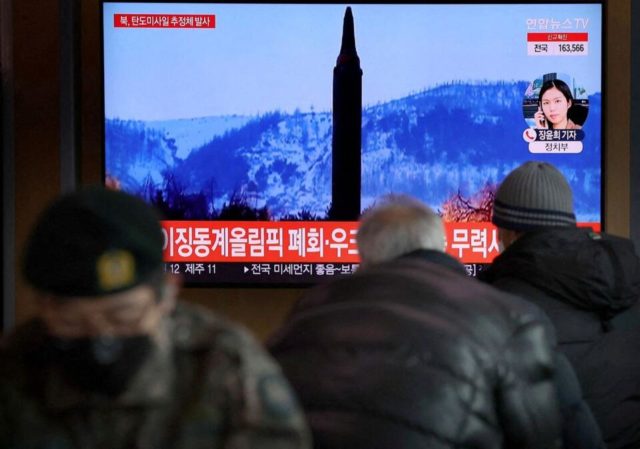North Korea’s decision to use the international airport near its capital city as a site for test-firing large missiles is ’absolutely bonkers’ and may be a way for leader Kim Jong Un to keep a close eye on his most prized weapons, analysts said.
By Josh Smith
SEOUL – North Korea’s decision to use the international airport near its capital city as a site for test-firing large missiles is “absolutely bonkers” and may be a way for leader Kim Jong Un to keep a close eye on his most prized weapons, analysts said.
Debris fell in or near Pyongyang after a failed test-fire from the airport on Wednesday, Seoul-based NK News reported, citing unnamed witnesses and a photograph of the test showing a red-tinted ball of smoke at the end of a zig-zagging rocket launch trail in the sky above the city.
There was no immediate confirmation of damage or casualties.
The launch underscored the danger behind North Korea’s decision to use the airport as a major site for test firing large missiles. The airport is in Sunan about 17km north-west of the North Korean capital.
“The idea of placing a dedicated facility to support developmental missile testing at North Korea’s major international airport is absolutely bonkers,” Jeffrey Lewis, a missile researcher at the James Martin Center for Nonproliferation Studies (CNS), said in a report on Sunday.
“This is a very strange airport,” he added. “And it’s been getting progressively stranger all the time.”
Since August 2017, North Korea has conducted an increasing number of major tests from the Sunan airport, including a pair of launches on February 27 and March 5 that US officials believe are developmental tests for the Hwasong-17 intercontinental ballistic missile.
With the construction of what analysts believe is a ballistic missile support facility, the airport could take on a major role as North Korea prepares to potentially conduct its first full-scale ICBM test since 2017.
Even before the Covid-19 pandemic ended international travel in and out of North Korea, the airport was hardly busy, with a handful of flights operating to cities in China and Russia.
But North Korea appears to be the only country to have conducted missile tests from its primary international airport, and could be planning to use the site to develop technology specifically related to its ICBMs, Lewis said.
In 2016 North Korea began constructing a facility next to the airport that appeared to be for ballistic missiles.
A high-bay building within the facility is tall enough to allow for North Korea’s largest ICBMs on launch vehicles to be easily elevated into the firing position to allow for testing of both, as well as the training of maintenance and ground crews, the U.S.-based Center for Strategic and International Studies (CSIS) said in a 2020 report, citing satellite imagery.
Dubbed the Sil-li Ballistic Missile Support Facility by CSIS, the complex also includes an unusually large covered rail terminal and buildings that are linked by drive-through access. The facility is also relatively close to ballistic missile component manufacturing plants in the Pyongyang area.
“The airport is likely favoured for its proximity to the capital, allowing Kim Jong Un potentially to attend and observe these launches, without his presence being reported,” said Ankit Panda, a senior fellow at the US-based Carnegie Endowment for International Peace. “Airports also provided large, paved areas for safely operating road-mobile launch vehicles.”
The Vienna-based Open Nuclear Network disputed media reports this week that said North Korea had built concrete pads to accommodate the launch of ICBMs at the airport, saying the activity was more consistent with agricultural development.
Wednesday’s failed launch is concerning given the airport’s proximity to Pyongyang, Panda said, noting that in 2017 a Hwasong-12 intermediate-range ballistic missile fired from a different location failed after launch and crashed into a populated area.
– REUTERS








